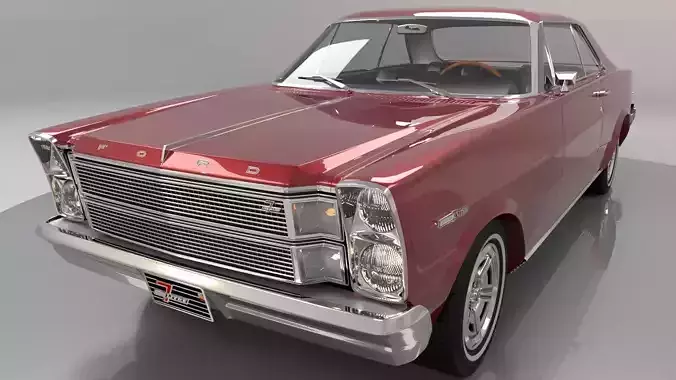1/22
This model was designed in Sketchup and converted to other formats using the buit-in sketchup converter. Rendering program is Vray 5. Textures in model from Sketchup and Vray libraries. Diferent parts of the model (steering wheel, lights, tires and wheels, wing mirrors, seats, etc.) are compiled in components and grouped in one single model.
This model is offered as it is.
The 1965 Galaxie was an all-new design, featuring vertically stacked dual headlights. The cars were taller and bulkier than the previous year's. The new top-of-the-line designation was the Galaxie 500 LTD and Galaxie 500 XL. The LTD and the XL trim package were accessory upgrades from the base Galaxie model. Engine choices were the same as 1964, except for an all-new 240 cu in (3.9 L) six-cylinder engine replacing the 1950s-era 223 Mileage-Maker six and the 352 was now equipped with dual exhausts and a four-barrel carburetor.
Suspension on the 1965 models was redesigned. Replacing the former leaf-spring rear suspension was a new three-link system, with coil springs. Interiors featured a new instrument panel, as well as two-way key vehicle access: the introduction of two keys was for valet parking, where the rounded head key would only open the trunk or locked glove compartment, while the squared-head key would only unlock the doors and the ignition.
The 1966 model had a slight Coke Bottle design and new horizontally split grille among other small changes.
A new model was introduced for 1966; the Galaxie 500 7 Litre, fitted with a new engine, the 345 hp 428 cu in (7.0 L) Thunderbird V8. This engine was also available on the Thunderbird and the S-55. The police versions received a 360 hp version of the 428 known as the 'Police Interceptor' as police cars. Safety regulations for 1966 required seat belts front and rear on all new cars sold domestically. The Galaxie 500 would be the number three-selling convertible in the U.S. in 1966, with 27,454 sold; it was beaten by the Mustang (at 72,119, by nearly 2.5:1) and by the Impala at 38,000. A parking brake light on the dashboard and an AM/FM radio were optional. The 1966 LTD dropped the Galaxie name: 423
The 1966 body style was introduced in Brazil (Ford do Brasil) as a 1967 model; it used the same platform and body throughout its lifetime until Brazilian production ended in 1983. A vehicle of this model was used by Queen Elizabeth during her visit to Chile in 1968, and has since been preserved by the Chilean government as a ceremonial state car.[30]
For 1967, the 7 Litre model no longer carried the Galaxie name; it was to be the last year of it being separately identified. That identification was mainly trim such as horn ring and dashboard markings as well as the Q in the Vehicle Identification Number. The 7 Litre for 1967 was a trim and performance option on the XL, which was now a separate model as well. Little else changed, except for trim and the styling; the same engines were available, from the 240 cu in (3.9 L) six-cylinder to the 428 cu in (7.0 L) V8. Modifications to the styling included adding a major bend in the center of the grille and making the model less boxy than the 1966 model. An 8-track tape cartridge player became an option. Back-up lights were standard.
For 1967 all models featured a large, padded hub in the center of the plastic steering wheel, along with an energy-absorbing steering column (introduced late into the 1967 model year), padded interior surfaces, recessed controls on the instrument panel, and front outboard shoulder belt anchors. Another safety related change was the introduction of the dual brake master cylinder used on all subsequent Galaxies (and other models).
The 1968 model had a new grille with headlights arranged horizontally, although the body was essentially the same car from the windshield back. The 'long hood, short deck' style with a more upright roofline and a notchback rear was followed too, as was the new trend for concealed headlights on the XL and LTD. One other change for 1968 was that the base V8 engine increased from 289 cu in (4.7 L) to 302 cu in (4.9 L). Standard equipment included courtesy lights, a cigarette lighter, a suspended gas pedal, and padded front seat backs.
The 1968 models featured additional safety features, including side marker lights and shoulder belts on cars built after December 1, 1967. The 1967 model's large steering wheel hub was replaced by a soft bar spoke that ran through the diameter of the wheel (and like the 1967 style, was used throughout the Company line). A plastic horn ring was also featured. (Wikipedia)
REVIEWS & COMMENTS
accuracy, and usability.






















